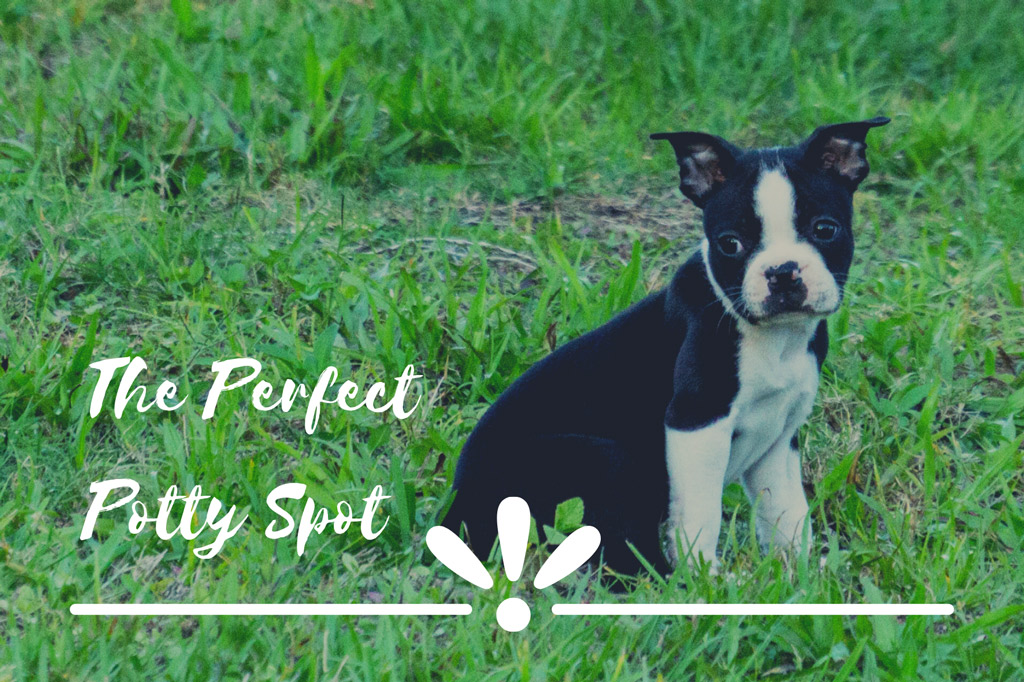
When bringing a dog into your home for the first time, there’s no doubt you’ll have one dominant thought in mind – Potty training AKA teaching your dog to not poo or pee indoors.
In fact, crate training goes hand in hand with housebreaking (house-training) since you are teaching your puppy the house rules.
Boston Terrier potty training is necessary to have a well-behaved pooch and accident-free home!
Boston Terrier Potty Training
Heads up: your Boston Terrier puppy won’t be fully housetrained, including potty trained, before he’s six months old.
Now that you know what to expect…
You should also know that a great deal is determined by the efforts you put into house-training him.
Having to train a little pup is similar to taking care of a baby – they both totally depend on you until they “learn”. I think it’s very important to know what you are facing, so you can put your efforts on effective training steps.
With that said, let’s dive into housebreaking your Boston Terrier!
Boston Terrier Potty Spot
Where should your puppy eliminate or relieve himself?
Choosing your dog’s toilet spot is one of the first things you can do to establish a routine.
Ideally, choose a place that is easily accessible and relatively quiet and that won’t get too muddy.
For example, choose a corner in the garden that isn’t too close to the streets so your dog won’t get distracted when it’s time for him to do his business.
For city dogs, choose a convenient spot near where you live.
Insider Tip: There’s also the option for puppy pads or choosing a potty spot inside the house, but the drawback to this is that your dog won’t recognize the spot by odour since you will be placing a clean pad after he eliminates.
But no matter which spot you decide on, it’s important that you train your dog to be comfortable in it. This is actually not a hard thing to accomplish since canines have an extremely powerful sense of smell.
It only takes peeing and pooping once for your doggy to recognize the spot after that. The smell of his pee and poop will trigger your dog’s desire to eliminate and speed up the whole process.
Especially when starting out with toilet training, it is very important to reward him immediately after eliminating on the chosen spot. This way you are encouraging him to repeat good behaviour.
Although it might seem more convenient to let your dog go and eliminate himself on his own in the garden, it becomes a problem when you are taking him outside on a lead (he will eliminate wherever or not at all).
Training your furry friend to eliminate using a lead will help you take your dog to his potty spot (reinforcing the toilet spot routine) and he will be comfortable going to the toilet wearing a lead (i.e. when going for walks).
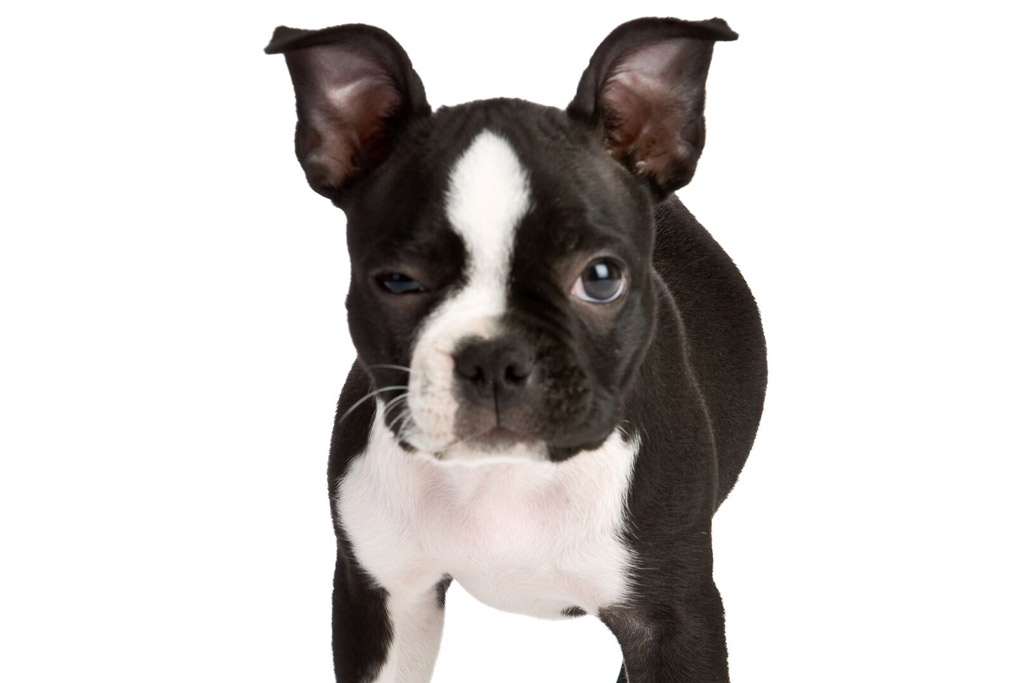
Boston Terrier Potty Signs
When starting to potty train your Boston, it makes a difference if you keep an eye on your dog so that you can pick up on pre-potty signals.
Most puppies follow a routine just before eliminating. Here are the signs to look for:
- Your pup whimpers.
- His tail is rising.
- He runs around in circles.
- Your puppy intently sniffs the ground in pursuit of the right spot.
- He paces restlessly.
- He chafes the door that leads to his potty spot.
- He moves out of the playing area.
- Your Boston squats.
As soon as you see any of these signs, stop whatever you’re doing, put his leash on and take him to his potty spot. If you arrive too late, don’t punish him. Instead, try to anticipate his needs by following a schedule.
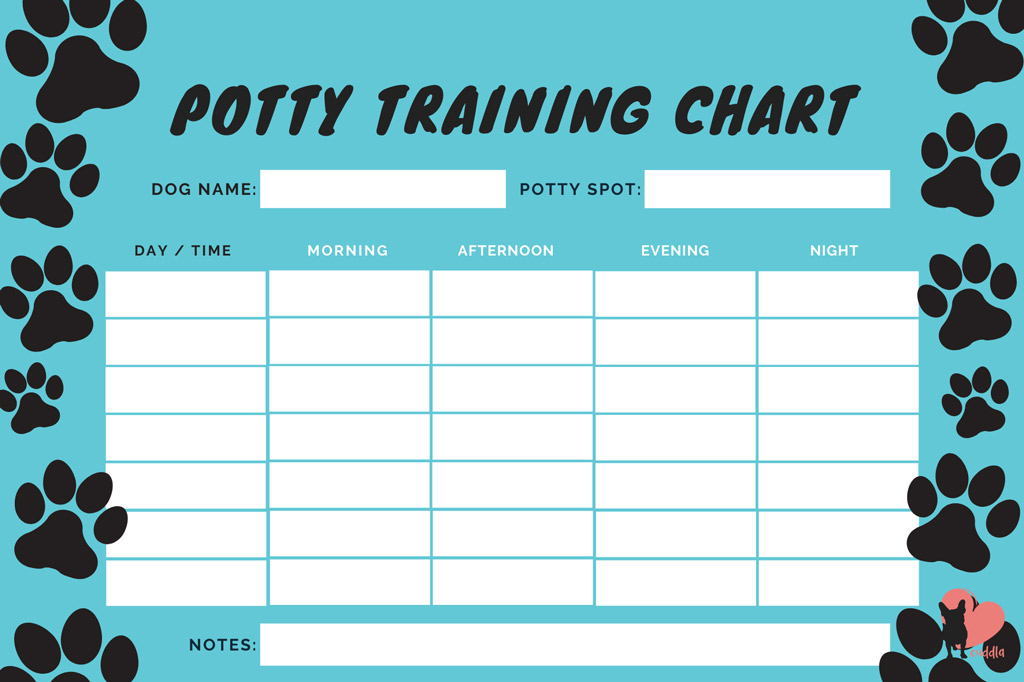
Boston Terrier Potty Schedule
Following a schedule breeds good behaviour and teaches your doggie that there is a time for everything: eating, playing, walking, napping, and even peeing and pooping! Also, a consistent feeding schedule will lead to a consistent elimination routine.
Apart from looking for the potty signs or clues, your Boston Terrier is likely to need to relieve himself in the following situations:
- First thing in the morning (immediately after he wakes up).
- After each meal.
- After drinking water.
- Soon after waking up from a nap.
- During and/or after playing and exercising.
- After gnawing on his chew toys.
- After any excitement.
- After a ride in a vehicle.
- After smelling another dog’s urine or seeing him pee.
- When he leaves his playpen or crate.
- Last thing at night (before he sleeps).
As you see, your dog needs to go out frequently. But don’t worry, as he gets older he’ll need to be taken outdoor less often.
How Long Can Boston Terriers Hold Their Bladder?
Your puppy won’t have bladder and bowel control before he’s 16 weeks old. So, he won’t be able to “hold it” for extended periods of time.
That’s why spotting the signs and following a schedule are key when potty training your Boston Terrier, and any other dog for that matter!
Insider Tip: As a general rule of thumb, puppies can hold their bladder one hour for every month of life. But avoid getting him too close to his limit in the beginning, until you are more familiar with his elimination needs.
On average, here’s how often your pup will need a potty break:
| BOSTON TERRIER’S AGE | POTTY BREAK EVERY |
|---|---|
| 8-10 weeks | 30 to 60 minutes |
| 2-3 months | 2 hours |
| 4 months | 4 hours |
| 18 months | 6 hours |
| Adult healthy dogs | 6 to 8 hours |
With a bit of practice, you will be able to anticipate your pup’s potty needs and reduce accidents indoors. However, you should also expect your puppy to have a handful of accidents.
Don’t be upset when these happen. Your dog just needs a bit more time to learn. Remember that dogs learn with repetition. Each time your pooch relieves himself on his potty spot and gets rewarded for it, you are reinforcing good practice.
Refer to the “Because Accidents Will Happen…” section below for more tips and cleaning tricks.
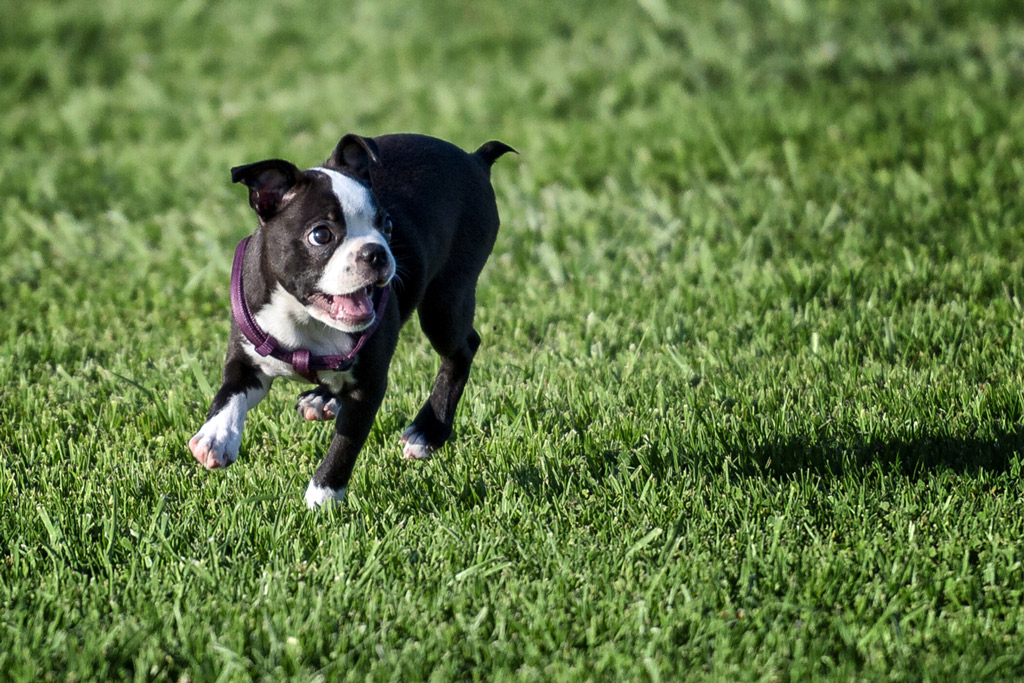
How to Potty Train a Boston Terrier Puppy
Note: These steps work for both puppy and adult Boston Terriers. There’s no difference between their potty training process. The only variation is that an adult dog can hold it a lot longer than a pup.
#1 – Choose a Potty Spot
As I mentioned before, potty training starts by picking a spot for your dog to pee and poo.
Depending on your situation and preference, decide if you intend to train your pup to potty outdoors or indoors. I went for a corner of my garden because I find this option more hygienic and it’s convenient enough.
If outdoors is not an option for you, use a specific spot of your house in the bathroom or balcony, for instance.
#2 – Take Your BT to the Potty Spot
Using a leash, take your dog to his potty spot immediately after you let him go outside or if you think he might need to potty according to his schedule.
Stand silently until he potties. When he’s done, reward him immediately to reinforce this behaviour. You can give him a treat, caress him or do something fun. I usually say “good boy” with a positive tone of voice and caress his head.
Just be cautious you don’t distract him from finishing, making sure that he’s really finished. Also, don’t rush back inside afterwards. Otherwise, he may consider it as a punishment and will quickly learn how to hold it in instead of letting it out.
If after a few minutes, he hasn’t potty, go back inside and try again in (say) 10 minutes’ time.
Insider Tip: Using a leash allows you to guide your Boston to the his spot, without him having to stop in-between places, avoiding the chance to potty before getting to his spot.
Also, whilst on a leash, your pooch cannot wander around and there are less chances for him to get distracted.
Finally, you can keep an eye on him, making sure he potties.
#3 – Practice the Potty Command
Don’t try to use your word as a command when you’ve just started potty training. Wait until you are sure your dog has made the connection between the word and the deed.
Once your pooch is comfortable with his potty spot and eliminates when you take him there, you can practice the “potty” command.
I usually use “pee”, regardless of what he’s doing. You can use “potty” or a more subtle command, just make sure you (and everyone else) always use the same one.
Wait until he’s squatting to say the command. this way, your Boston Terrier will associate the command with the action.
To level up your training, you can send your pooch to potty at his spot. Use the cue word just once – “go potty” or “go pee” – in a clear, motivating voice. At the same time, point with your finger to his potty spot.
At first, you can practice this closer to his spot and then stand a step further from it. By the end of the training, your pooch will be going to his spot on command.
Insider Tip: Refrain from saying the cue again and again, or it’ll just turn into noise for him. Granted this is easier said than done, as I still sometimes struggle to hold my tongue back! It’s something to keep in mind and remember, and also to keep practising!
#4 – Supervise Your BT At All Times
Until you’re convinced that your BT is reliable, he should be directly monitored or next to you rather than left alone to wander around the house without supervision.
This is when crate training comes in handy. Not only to teach your dog to be okay by himself for a while, but also to keep an eye on him. Plus, you will minimize potty accidents.
Also, dog-proofing your home and garden will make sure to keep him safe and out of trouble.
Read also: How to Make Your Home Dog-Friendly and How to Make Your Garden Dog-Friendly.
When you cannot actively keep an eye on him, you can keep your Boston limited to his crate, playpen or gated safe zone (dog room) for a while.
#5 – Follow a Potty Schedule
However, remember to take him to potty according to the potty schedule guideline I mentioned above.
Using our “Potty Training Chart” will make it easier for you (and everyone in your household) to track your Boston Terrier’s potty deeds.
You can make a note of the time he is fed and roughly what time he goes for a pee and poop. This will give you a rough guide of when he is likely to need to go out next.
#6 – No Matter What, Stay Consistent
In order to maximize potty training, stick to this routine every time and every day. The more consistent you are in implementing this method, the faster your Boston Terrier pup will learn where to potty. Consistency and repetition are key for him to learn.
Also, rewarding his actions will encourage him to repeat this behaviour. You want your dog to make the association that going outside is THE BEST thing EVER!
Plus, a routine teaches your Boston what to expect!
When you are confident his training is complete, you can begin to (very) gradually reduce the amount of praise you give him, and then let him go out alone, praising him when he comes back in.
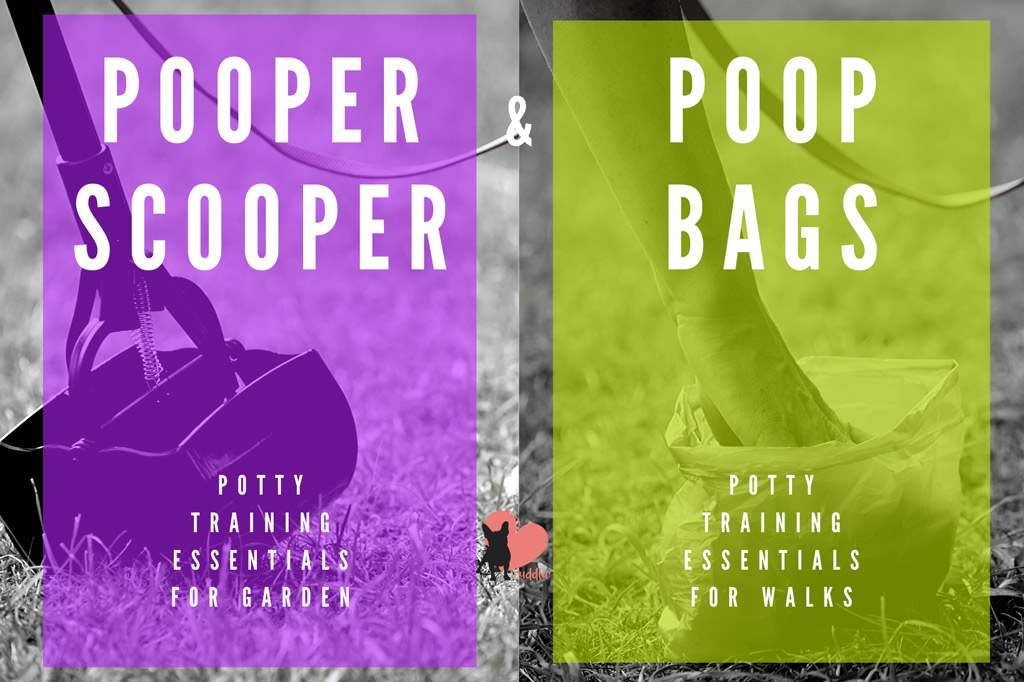
Potty Training Essentials
You don’t need much.
But, it’s important to keep your dog’s potty spot clean. Because if the area becomes too soiled, your Boston may check out another place to relieve himself.
This is what I use:
Pooper Scooper
After your dog uses his potty spot, make sure to clean up his poop. Personally, I use a pooper scooper (Amazon link). I prefer a two-piece pooper scooper; it comes with a rake and bin/tray. It’s long-lasting, hygienic and comfortable to use.
Also, I keep it in a corner of my garden, where I also have a bin that comes in very handy.
Poop Bags
You can use the poop bags with the pooper scooper (I personally don’t). However, I found these poop bags very useful to clean up home accidents and to take during walks or when we leave the house.
Because Accidents Will Happen…
During potty training, home accidents are inevitable; however, how you respond to them will prevent future accidents.
These are the three scenarios you can find yourself in:
- You catch your dog in the act.
- You find the evidence.
- Your house-trained dog is still having accidents indoors.
And here is what you can do when you find yourself in each situation:
What To Do If You Catch Your Dog In The Act
If you catch your dog toileting indoors or you think they are about to go, try and interrupt them by calling them in an excited tone and getting them into the garden.
It’s important NOT to punish your dog because he may come to associate going to the toilet in front of you with punishment. In the future, your dog may worry about going to the toilet in front of you and waiting until you get home to sneak off into a hidden place.
Even if your Boston Terrier initially makes a mistake, make sure you give lots of praise when he goes to his potty spot.
What To Do If You Find The Evidence
If you don’t catch your dog in the act because you weren’t present, there is nothing you can do. Reprimanding your Boston after the act will have no effect. He will not associate the punishment with the earlier action.
So, it’s best to clean up accidents without comment. This can be difficult when it’s your carpet – yet again – don’t shout, smack, rub his nose in it, or point to the spot and snarl. He won’t know why you are angry.
When cleaning up after your dog, avoid any household detergents that contain ammonia. This is a natural chemical that occurs in your dog’s urine and will encourage them to mark the area again.
What To Do If Your House-Trained Dog Is Still Having Accidents Indoors
As well as not being housetrained, there are many other reasons why a Boston will relieve himself in the house. For example, he might do it because he’s stressed about being left alone.
Dogs are social creatures who get lonely and bored when forced to stay alone for long stretches. If you are concerned about your dog being alone at home, check out the 10 Steps to Dog Home Alone Safety and How to Keep My Dog Entertained While at Work blog posts.
Your dog might still soil indoors due to:
- Urine marking behaviour: If your pup is over three months of age and pees small amounts on vertical surfaces, he could be urine marking. Young male dogs doing this behaviour often elevate their hind legs when peeing.
- Separation anxiety: If your puppy only soils the floor when he’s left alone at home, even for short time frames, he may have separation anxiety. If this is the case, you may observe that he appears anxious or upset right before you leave him by himself. Go to Boston Terrier Separation Anxiety – 16 Things that Help blog post.
- Submissive/excitement urination: Your Boston Terrier may have submissive or excitement urination behaviour if he only pees during greetings, play, and physical contact. If this is the case, you can also observe your pup displaying submissive postures during interactions. He may flinch or cower, roll over on his belly, tuck or lower his tail, duck his head, avert his eyes, flatten his ears or all of the above.
- A Change in diet: If you have recently modified the quantity or type of food you give your puppy, he may develop a house soiling issue. Often, following a diet change, a pup will defecate loose stools or have diarrhoea. He may need to poop more frequently or on a different schedule than before the diet change. In What Do Boston Terriers Eat? you’ll find options for a balanced diet for your pooch.
However, if you suspect there is an underlying problem and the steps above are not working, you can:
- Consult with your vet to make sure it’s not a health-related issue like Urinary Tract Infection (UTI) or an upset stomach.
- Get our Dog Training Essentials (more details below).
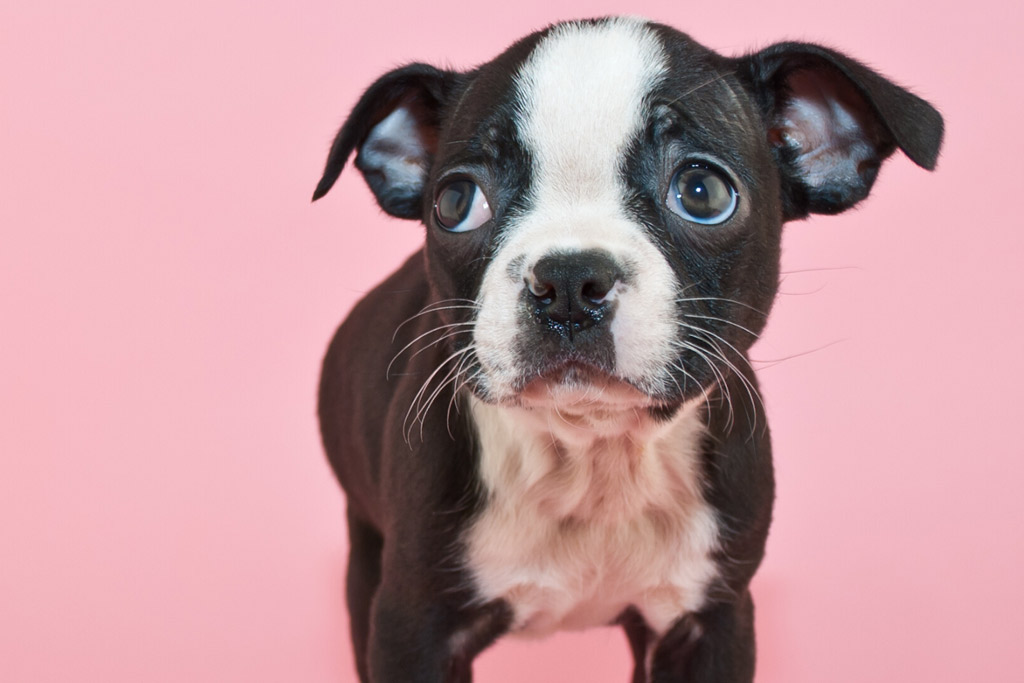
What’s Next
Are you finding potty training hard? You are not alone! Potty training is one of the 3 most common challenges dog parents face alongside:
- Leash pulling.
- Biting/nipping.
I may be able to help you further down this challenging training process. Click here to visit our Dog Training Essentials, where you will get a 3-part mini audio series + the everyday resource used by a well-known dog trainer.
You can also get this using the button below. Happy training! 😉

I was wondering what you would recommend for my situation
I am currently awaiting the arrival of my Boston terrier.
I live in a flat on the second floor with a small balcony and a small grassy area surrounding the building. A small park across the road.
I was planning on using puppy pads for the first few weeks, but I wondered if it would be wise to train the puppy to potty on the balcony until he is slightly older. My only concern is getting him downstairs quickly enough to go potty. I don’t want him to have an accident on the stairs, I would more than likely carry him for time and safety, but I want to make sure I set him up for success.
Thanks in advance xx
Hi Jayne! Thanks for your comment.
I agree with you about puppy pads in the balcony in the beginning.
Puppies cannot hold their bladder for too long and it’s likely for accidents to happen whilst you are trying to get to the green area near your flat. Plus, it’s not easy to go out into the garden, in the middle of the night, for a potty break.
So, it sounds like a good plan to start potty training in the balcony. I would encourage you to use a leash, just think of it as a prop for later to help to transition from the balcony potty spot to one in the garden next to your building!
By guiding your Boston to the spot, waiting for him/her and then rewarding the good behaviour teaches your pup what you want him/her to do and where.
Let me know how it goes. 🙂
Best wishes to you and your pup! xx
Hi Lily! I have a BT( female) she is two and a half years old (born on September 24) and is still doing her needs in the room she sleeps in: she doesn’t do it everyday but regularly. First, when we just got her we used puppy pads, she used them but did on the floor as well. After, when nothing was helping, we bought a cage, it helped ENORMOUSLY , she didn’t do anything anymore. After a year maybe, we decided we didn’t want to keep the cage forever so we removed it. For a few months everything was perfect until one morning. I find a pool of pee on the floor. I am shocked Bcs it was the first time in a long time that she did her needs on the floor again. Before this incident, we explained the situation to our vet and he said that maybe it was a food problem ( we were feeding her in the morning and the evening). He said we should try giving her the whole portion in the morning (that’s what we did). Then came the incident. And during the time when she had those incidents, she got sterilized ( giving all the info possible).Since then she has been doing it regularly and after having done it, eating it. I suppose she does it in order to hide it… she now sleeps outside for we do not know what to do… I would really appreciate your help and advice…
Best regards!
Hello Aglaya,
We’ve got 3-part audio series which goes into depth on the toilet training following the proven methods that Doggy Dan, AKA The Online Dog Trainer, uses to help dog owners just like YOU to get sure fire results, every time! There you’ll find out why timing & monitoring how often she goes matters, controlling the environment, rewards, and the one thing most dog owners are missing. It’s called Dog Training Essentials, which you’ll find here: https://cuddla.com/dog-training-essentials/
Hope you find that useful. Hugs, Lily.